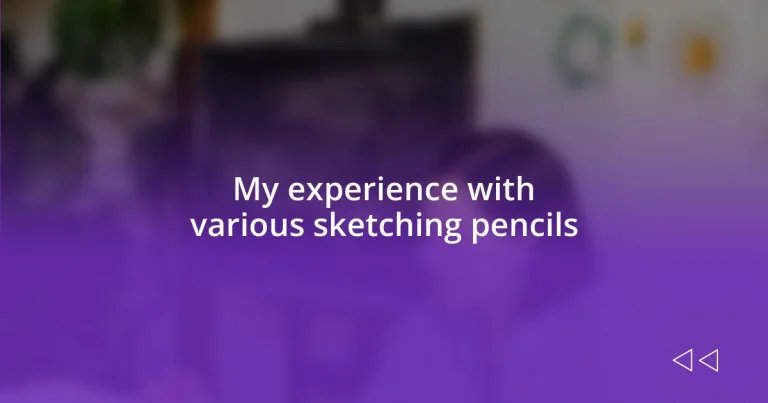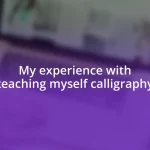Key takeaways:
- The exploration of different sketching pencil types, including graphite, colored, and charcoal, enhances artistic expression and offers various textures and effects.
- Experimenting with pencil hardness and pressure can dramatically impact sketching techniques and the final artwork, allowing for a blend of fine details and rich shading.
- Developing a connection with sketching tools influences an artist’s mood and creativity, highlighting the personal narrative that evolves through each sketching experience.

My introduction to sketching pencils
My first encounter with sketching pencils was a delightful surprise. I remember walking into an art supply store, feeling slightly overwhelmed by the variety on display. Why were there so many options? Each pencil seemed to whisper its potential to capture the world around me.
As I picked up my first graphite pencil, I felt a rush of excitement mixed with trepidation. I still recall the moment I made my first mark on paper—just a simple line, but it sparked a sense of creativity that I’d never experienced before. The smooth glide of the pencil against the page was intoxicating, and suddenly, I was hooked.
Over time, I began to explore different grades of pencils, from soft to hard, and I quickly learned how each one created unique textures in my sketches. The softer pencils felt like a warm hug, offering depth and richness, while the harder ones provided crisp, clean lines. Isn’t it fascinating how something as simple as a pencil can open up a whole new world of creativity?

Types of sketching pencils available
When exploring the types of sketching pencils available, I quickly found that they fall into a few primary categories. Graphite pencils are the backbone of any artist’s toolkit; they range from 9H (very hard) to 9B (very soft), with varying degrees in between. I think the versatility of graphite is impressive, as I sometimes switch between hard pencils for fine details and soft ones for shading.
Colored pencils also piqued my interest early on. They come in a range of hues and types, from wax-based to oil-based. I remember the first time I laid down multiple colors; it was like watching a sunset unfold on paper. The way colors blended and layered was mesmerizing, offering a different dimension to my sketches that graphite simply couldn’t achieve.
Charcoal pencils are another fantastic option, known for their rich, velvety darkness. There’s something about the boldness of charcoal that feels liberating. I remember a sketching session where I let loose with a charcoal pencil, creating dramatic shadows and expressive lines—it felt almost like dancing on the paper. Each type of pencil offers a unique experience, allowing artists to express their creativity in diverse ways.
| Type | Description |
|---|---|
| Graphite | Versatile, range from hard (H) to soft (B) |
| Colored | Available in various hues and types (wax, oil) |
| Charcoal | Bold, velvety texture for dramatic sketches |

Choosing the right hardness scale
Choosing the right hardness scale can be a game-changer for any sketching experience. I remember my first attempt at shading with a 6B pencil—it was like unleashing a flood of creativity, as the dark pencil stroked across the page with such ease. But then I switched to a 4H pencil for detail work, and I struggled more than I expected; its crispness felt almost foreign to my fingers. The key is to understand that each hardness level has its own personality and function in your artwork.
- H Pencils: Great for fine lines and detailed work; perfect for initial sketches.
- F Pencils: A balance between hard and soft, ideal for general-purpose drawing.
- B Pencils: Excellent for shading and creating bold, dark lines; they add depth and texture.
- 2B and 4B: My go-tos for blending; they glide across the paper, providing rich tones that bring sketches to life.
Finding the right pencil hardness for the technique or style you prefer requires experimentation. It’s worth trying out different pencils until you discover your personal favorites.

Testing different pencil brands
As I ventured into testing different pencil brands, I was curious to see how they compared to my beloved favorites. Trying out a brand I hadn’t used before was like opening a new chapter in my sketching journey. I remember feeling a mix of excitement and skepticism. Would this new brand live up to the hype?
I decided to put them to the test side by side. The initial strokes felt different with each pencil, almost like conversing with new friends. I was particularly surprised by how one brand’s 2B pencil glided so smoothly across the paper, inviting me to sketch with confidence. In contrast, another brand’s pencil felt more scratchy, making it a challenge to achieve the soft shading I desired. Have you ever noticed how the texture of a pencil can change your entire approach to drawing? It’s quite astounding how something seemingly simple can have such a profound impact on the sketching experience.
After switching from one brand to another multiple times, I began to form a distinct preference for those that offered better control and consistency. One evening, while experimenting, I managed to create a landscape that felt alive with detail, largely due to the quality of the pencil I was using. Each brand has its own charm and quirks, but what truly matters is how they resonate with your personal artistic expression.

Techniques for using sketching pencils
When I sketch, I often use varying pressure to create depth and dimension. Initially, I would press down hard to create dark lines, but I quickly learned that a lighter touch could yield some remarkable effects. For example, gently feathering the pencil allows softer shadows to develop gradually, creating a more realistic illusion of light and form. Have you ever noticed how just a subtle change in pressure can transform a flat sketch into something more dynamic?
Another technique I’ve embraced is hatching and cross-hatching, especially with my softer B pencils. I find that laying down parallel lines and then layering another set at an angle can form rich textures and shadows. One evening, while sketching a still-life of fruits, I became engrossed in this technique, watching how the simple addition of intersecting lines brought volume to the apples and a sense of realism to the scene. It was exhilarating; I felt like I was unlocking new depths in my art. Have you ever tried to hatch your way to creating texture?
I’ve also discovered the impact of blending tools alongside my sketching pencils. Using a blending stump or even my finger for softer transitions became a game-changer in my sketches. I remember blending the soft edges of a sky I had drawn with my 2B pencil, and it felt like magic as the colors melted into each other. It made me realize how important it is not only to create with a pencil but to think about how those marks can be transformed further. What tools, have you experimented with to elevate your sketches?

Comparing sketching pencil textures
When it comes to sketching pencil textures, I have come to appreciate the subtle nuances each type brings to my work. For instance, I remember trying a high-quality graphite pencil once, where the smoothness felt almost luxurious against the paper. The way it glided allowed me to experiment freely, capturing the fleeting details of a subject. There was a distinct joy in how the pencil met the page; it made the entire process feel almost effortless and inspired creativity.
On the other hand, I stumbled upon a set of charcoal pencils not too long ago. Their coarse texture presented a stark contrast to the graphite, producing rich, dark lines that exude drama and depth. Initially, I struggled with their intensity, but once I embraced their character, I found myself captivated by the boldness they offered. Have you ever felt that rush of excitement overcoming the initial challenges of a new medium? That transformation in my approach made each stroke feel like a statement rather than just a sketch.
I’ve also explored colored pencils with varying textures. One brand felt almost waxy and produced vibrant, saturated colors that excited my inner artist. It reminded me of painting with a brush, which is a different sensation altogether. But there was another brand where the texture was drier, requiring a bit more pressure yet rewarding me with a surprising array of shades through layering. I often find myself pondering, how much does the texture really shape our artistic voice? Each pencil, unique in its feel, has truly taught me that textures play a pivotal role in how we express ourselves on paper.

Final thoughts on sketching pencils
As I reflect on my journey with sketching pencils, I can’t help but appreciate how each type has shaped my artistic expression. There was a time when I thought all pencils were the same, but my experimentation opened my eyes to their unique characteristics. Do you ever feel that thrill when you discover a new tool that transforms your work? I still remember my first attempt at using a mechanical pencil; the precision it offered allowed me to capture fine details I never thought I could achieve.
What fascinates me even more is how my choice of pencil can influence my mood while I sketch. Some days, I gravitate towards the softer B pencils, where the deeper strokes resonate with my emotional state, allowing me to convey a sense of drama in my artwork. On other days, I find solace in the crisp lines of an H pencil, where the sharpness feels like clarity, reflecting a different aspect of my creativity. Have you noticed that your mood influences your artistic choices? I’ve learned that dictating my medium can lead not just to different styles, but to different feelings and thoughts emerging on the page.
Ultimately, the real magic lies in how sketching pencils let me explore my imagination. Every stroke reveals a part of me that I might not have fully understood yet. I’ve come to realize that it’s not just about the pencil itself but the relationship I develop with it over time. What have your sketching experiences taught you about your creative journey? The ability to connect with these tools has enriched my artistic life in countless ways, making each sketch a personal narrative that evolves with every mark I make.














